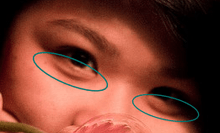Periorbital puffiness


Periorbital puffiness, also known as "puffy eyes" or swelling around the eyes, refers to the appearance of swelling in the tissues around the eyes, called the orbits. It is almost exclusively caused by fluid buildup around the eyes, or periorbital edema. Minor puffiness usually detectable below the eyes only (although at times they could be present all around) is often called eye bags. Such transient puffiness is distinct from the age related and gradual increase in the size of the fat pad lying below the lower eye lids (suborbicularis oculi fat - "SOOF") which can also be colloquially referred to as eye bags.[1]
Causes
While some degree of puffiness may be normal for a given individual, factors such as age and fatigue may make the swelling more prominent. The periorbital tissues are most noticeably swollen immediately after waking, perhaps due to the gravitational redistribution of fluid in the horizontal position.
Eye puffiness may also be caused by:
- Mononucleosis - With supra-orbital oedema, the eyes become puffy and swollen. This may occur in the early stages of infection.[citation needed]
- Oversleeping/sleep deprivation - Interrupted sleep cycles are common causes of eye puffiness.[citation needed]
- Fluid retention - Many conditions (including pregnancy and hormonal variations with menstruation) can lead to the retention of fluid, particularly in the subcutaneous tissues. These conditions can cause swelling around the eyes to be more prominent. (This cause can by partly alleviated by raising the head of one's bed.)[citation needed]
- Diet - Excess salt encourages fluid retention and may lead to puffy eyes. (This cause can by partly alleviated by paying more attention to salt intake and becoming aware of the large amount of sodium in common processed foods. In addition, exercise helps remove salt through sweat.)[citation needed]
- Alcohol and tobacco use - Alcohol and tobacco contain toxins that may lead to stress, fatigue, and hormonal changes; all of which may lead to fluid retention and swelling around the eyes.[citation needed]
- Allergies - Allergic reactions can lead to leaks in the subcutaneous capillary beds which can cause swelling in the face, including around the eyes.[citation needed]
- Skin disorders - Eye puffiness can be a side effect of certain skin disorders, such as dermatitis, if the affected area becomes very sensitive, leading to swelling.[citation needed]
- Normal aging - As a person grows older, the skin around the eyes becomes thinner and may swell or droop.[2] Further a gradual and generally permanent increase in the size of the suborbicularis oculi fat pad along with the thinning and weakening of the overlying musculature contributes to the apparent distention of the lower eye lids.[3]
- Hypothyroidism - Facial puffiness and periorbital swelling occur due to infiltration with the mucopolysaccharides hyaluronic acid and chondroitin sulfate,[4] pulling fluid into the interstitial space by osmosis.
- Periorbital cellulitis - An inflammation and infection of the eyelid and portions of skin around the eye.
- Chagas disease - Also known as American trypanosomiasis. Young patients, often in an acute phase of the disease, manifest Romaña's sign: unilateral, painless, periorbital edema.[5]
- Nephrotic syndrome - Puffiness around the eyes is the first site to get swollen[citation needed]
- Trichinosis - Periorbital edema, fever and muscle pain are the main symptoms that ensue from eating raw, infected pork.[citation needed]
- Tear glands - Puffiness around the eyes can also be due to the improper functioning of the tear glands.[citation needed]
- Superior vena cava obstruction.[citation needed]
- Cavernous sinus syndrome polyneuropathy.[6]
Risks
Puffy eyes are usually only a temporary cosmetic worry, but occasionally, individuals become concerned about the cosmetic effect of periorbital swelling and seek surgical correction. Severe and persistent puffiness may be a sign of other serious medical conditions.
Remedies
For someone predisposed to eye puffiness, changes to diet and lifestyle (under the supervision of a physician) may be required to reduce the possibility of swelling. A cold compress near the eye can act as a short-term remedy as cold temperature constricts blood vessels, preventing the flow of fluid into tissues and diminishing puffiness in the process.[7]
Live Yeast Cell Derivative (LYCD) may be effective,[8] however for reasons that are unclear it was banned in the USA by the FDA in 1993. It is available everywhere else [citation needed].
Prevention
Elevating the head while sleeping can prevent the gravitational redistribution of fluid that is associated with eye swelling. A low-carb diet can prevent eye puffiness by preventing water retention. Eating foods rich in vitamins, especially A, C and E, helps to reduce eye puffiness and to maintain clear, moist skin.[9]
See also
References
- ↑ Plast Reconstr Surg. 1995 Jan;95(1):37-42.The suborbicularis oculi fat pads: an anatomic and clinical study. Aiache AE, Ramirez OH.
- ↑ The Look You Like; Paul Lazar, M.D.
- ↑ Plast Reconstr Surg. 1995 Jan;95(1):37-42.The suborbicularis oculi fat pads: an anatomic and clinical study. Aiache AE, Ramirez OH.
- ↑ The Merck Manual, 18th Edition, Merck Research Laboratories, 2006.
- ↑ Markell and Voge's Medical Parasitology, John and Petri, Ninth Edition
- ↑ Carroll GG. Multiple Cranial Neuropathies. Semin Neurol. 2009;29(1):53-65. http://www.medscape.com/viewarticle/588522_9
- ↑ The Doctor's Beauty Hotline; Fredric Haberman, D.D.
- ↑ http://www.google.com/patents/US5643587?dq=live+yeast+cell+derivative&hl=en&sa=X&ei=sAPGUNbYH4vIswaMtICQBQ&ved=0CEkQ6AEwBg Composition and method for under-eye skin lightening USPTO Patent number: 5643587
- ↑ Nourishing your skin from within